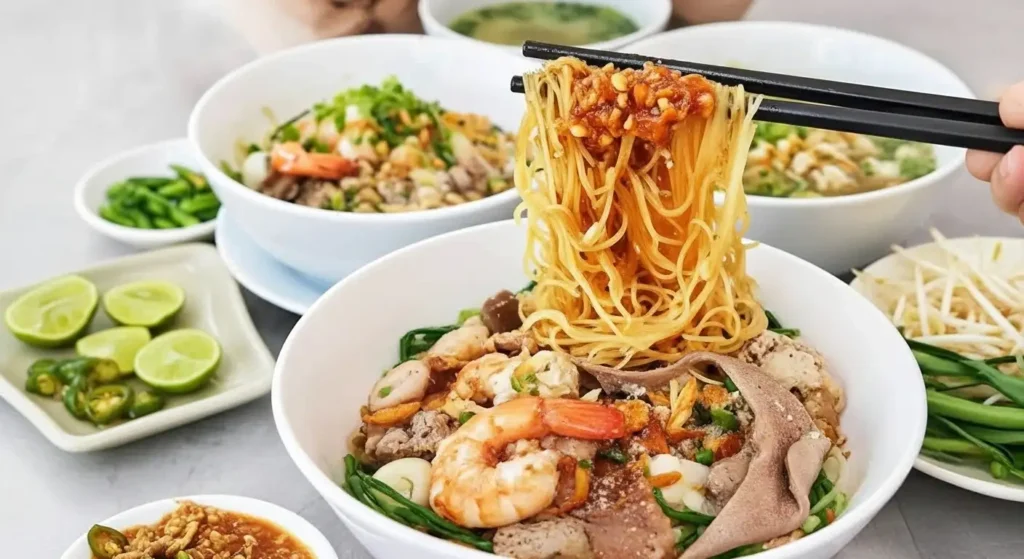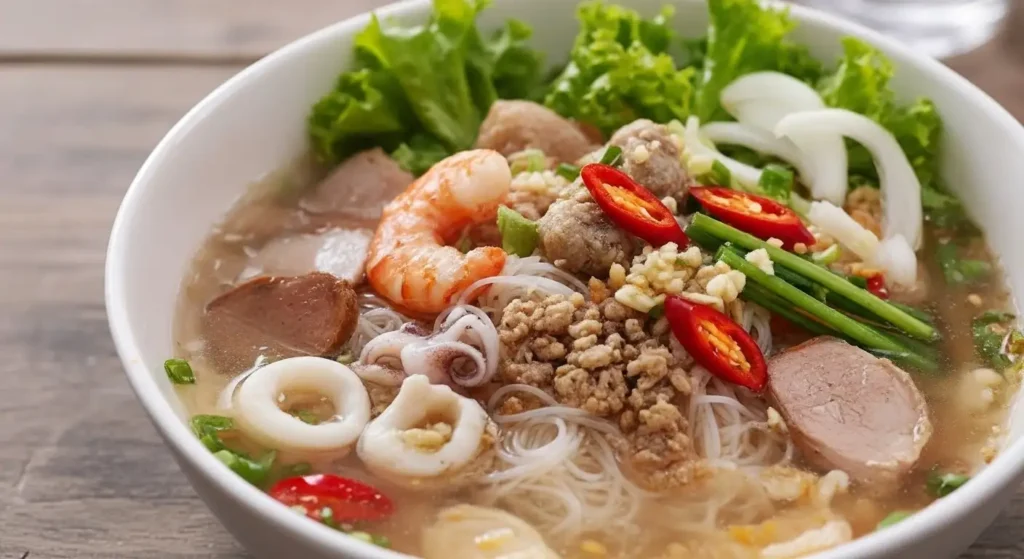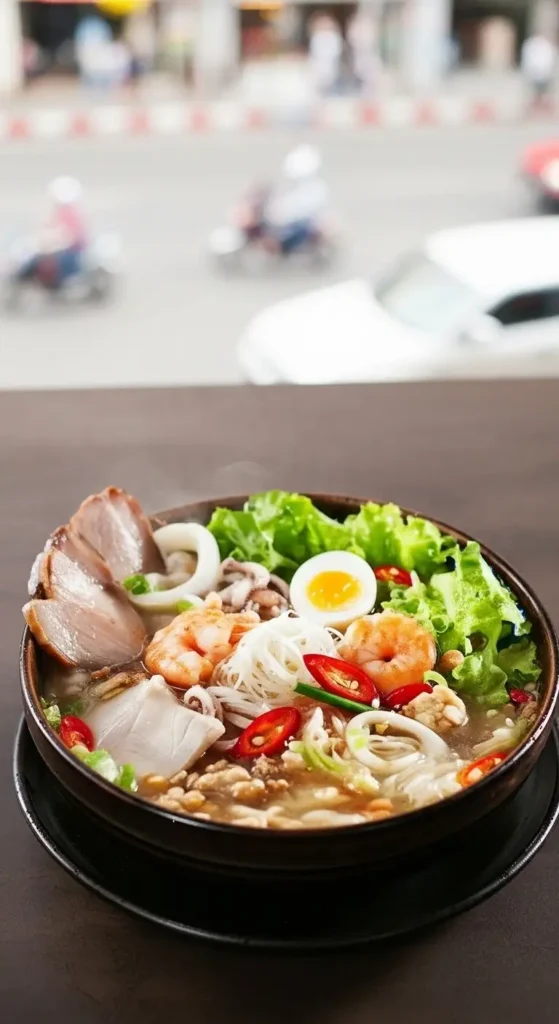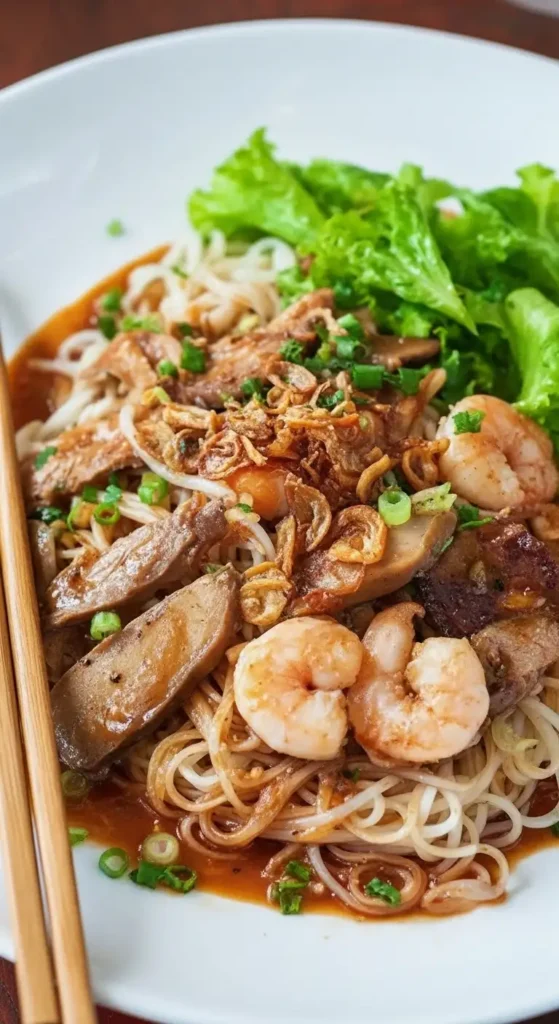Hủ Tiếu (often pronounced “Hoo-Tiew”) is one of Southern Vietnam’s most celebrated and versatile noodle dishes. Unlike the Northern Phở, which is known for its beef-based broth and simplicity, Hủ Tiếu is a vibrant, flavorful noodle soup heavily influenced by Chinese (Teochew) and Cambodian culinary traditions, making it a distinct culinary experience. It is a staple from breakfast to late-night street food across Ho Chi Minh City and the Mekong Delta.

Hủ Tiếu: The Basics
Origin and Influence: Hủ Tiếu traces its roots to the Teochew Chinese and the Cambodian dish Kuy Teav (Nam Vang is the Vietnamese name for Cambodia’s capital, Phnom Penh). It became immensely popular in Southern Vietnam, particularly Saigon, starting in the 1950s and 60s.
The Broth: The heart of the dish is a clear, savory, and often subtly sweet broth traditionally made by simmering pork bones, dried shrimp, and sometimes dried squid for many hours. This clear, rich broth sets it apart from the often cloudier broths of other Chinese-influenced noodle soups.
The Noodle: The word Hủ Tiếu specifically refers to the thin, often slightly chewy rice noodles used. However, the dish is unique in that diners can frequently choose their preferred noodle, including egg noodles (mì), clear tapioca noodles, or a combination.
Toppings: Toppings are abundant and diverse, creating a hearty bowl. Standard ingredients often include sliced pork loin, minced pork (sautéed or boiled), shrimp, quail eggs, and slices of pork liver or other offal.
Key Garnishes: Always served with fresh ingredients like Chinese chives, fried shallots, cilantro, and bean sprouts.
Variations of Hủ Tiếu
Hủ Tiếu is perhaps the most versatile of Vietnamese noodle soups, boasting numerous regional and style variations:
| Vietnamese Name | Key Ingredients/Features |
|---|---|
| Hủ Tiếu Nam Vang | The most famous version. Toppings include all the "deluxe" ingredients: sliced pork, minced pork, shrimp, pork liver, and quail eggs. |
| Hủ Tiếu Mỹ Tho | Known for its distinctive, slightly thicker, clear, and chewy rice noodles (Hủ Tiếu dai). |
| Hủ Tiếu Sa Đéc | Often uses a unique, soft, and slightly translucent rice noodle (Hủ Tiếu bột lọc) and focuses on a purer pork-bone broth. |
| Hủ Tiếu Nước | Noodle Soup with Broth. |
| Hủ Tiếu Khô | Dry" Noodle Soup (Noodles without broth). |
How to Eat Hủ Tiếu
Hủ Tiếu is a customizable experience, whether you choose the soup (nước) or dry (khô) version.
Add Condiments: Upon receiving your bowl, you will usually have a selection of condiments. Add chili sauce or chili oil for heat, and a dash of soy sauce for extra savoriness, especially if you order the khô version.
Squeeze Lime: A wedge of lime is essential to brighten the soup’s flavor and cut through the richness of the pork broth.
Mix in Herbs: Place the raw side vegetables, such as bean sprouts and Chinese chives, directly into the hot soup to lightly wilt them. This adds freshness and crunch to the dish.
Dry Style (Hủ Tiếu Khô): If you order the dry version, mix the noodles well with the sauce at the bottom of the bowl first. Enjoy the coated noodles and toppings, using the separate bowl of broth as a palate cleanser or to dip the meat and vegetables.
Listen for the Crunch: The crunch of fried garlic/shallots and the fresh snap of the bean sprouts are integral to the dish’s texture—don’t forget to include them!

Regional Differences
Hủ Tiếu is primarily a Southern Vietnamese dish, so the significant variations exist mainly within the Southern region (e.g., Nam Vang, Mỹ Tho, Sa Đéc).
| Region | Flavor Profile and Focus | Noodle Preference |
|---|---|---|
| Northern Vietnam (Hanoi) | Hủ Tiếu is rarely found or considered a local specialty. The dominant noodle soup is Phở, characterized by a savory, balanced, and non-sweet broth. | N/A |
| Central Vietnam (Hue, Da Nang) | Hủ Tiếu is not a local staple. The cuisine is known for being spicier and bolder, with specialties like Bún Bò Huế (Spicy Beef Noodle Soup) and Mì Quảng. | N/A |
| Southern Vietnam (Ho Chi Minh City & Mekong Delta) | The undisputed home of Hủ Tiếu. The broth tends to be sweeter than its Northern counterparts (reflecting a general Southern preference for sweetness), richer, and often more complex due to the heavy inclusion of seafood (shrimp/squid) in the stock. | Versatile—ranging from the thin, chewy hủ tiếu dai (Mỹ Tho style) to the more traditional rice noodles. |




